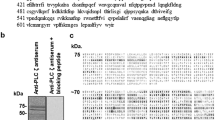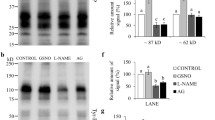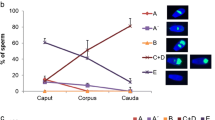Abstract
In mammalian species, acquisition of sperm fertilization competence is dependent on the phenomenon of sperm capacitation. One of the key elements of capacitation is protein tyrosine phosphorylation (TP) in various sperm membrane regions. In previous studies performed, the pattern of TP was examined in human sperm bound to zona pellucida of oocytes. In the present comparative study, TP patterns upon sperm binding to the zona pellucida or hyaluronic acid (HA) were investigated in spermatozoa arising from the same semen samples. Tyrosine phosphorylation, visualized by immunofluorescence, was localized within the acrosomal cap, equatorial head region, neck, and the principal piece. Tyrosine phosphorylation has increased in a time-related manner as capacitation progressed, and the phosphorylation pattern was identical within the principal piece and neck, regardless of the sperm bound to the zona pellucida or HA. Thus, the data demonstrated that the patterns of sperm activation-related TP were similar regardless of the spermatozoa bound to zona pellucida or HA. Further, sperm with incomplete development, as detected by excess cytoplasmic retention, failed to exhibit TP.
Similar content being viewed by others
References
Yanagimachi R. Fertility of mammalian spermatozoa: its development and relativity. Zygote. 1994;2(4):371–372.
Travis AJ, Kopf GS. The role of cholesterol efflux in regulating the fertilization potential of mammalian spermatozoa. J Clin Invest. 2002;110(6):731–736.
Demarco IA, Espinosa F, Edwards J, et al. Involvement of a Na+/ HCO-3 cotransporter in mouse sperm capacitation. J Biol Chem. 2003;278(9):7001–7009.
Harayama H, Muroga M, Miyake M. A cyclic adenosine 3’,5’-monophosphate-induced tyrosine phosphorylation of Syk protein tyrosine kinase in the flagella of boar spermatozoa. Mol Reprod Dev. 2004;69(4):436–447.
Harayama H, Nakamura K. Changes of PKA and PDK1 in the principal piece of boar spermatozoa treated with a cellpermeable cAMP analog to induce flagellar hyperactivation. Mol Reprod Dev. 2008;75(9):1396–1407.
Barbonetti A, Vassallo MR, Cinque B, et al. Dynamics of the global tyrosine phosphorylation during capacitation and acquisition of the ability to fuse with oocytes in human spermatozoa. Biol Reprod. 2008;79(4):649–656.
Wertheimer EV, Salicioni AM, Liu W, et al. Chloride is essential for capacitation and for the capacitation-associated increase in tyrosine phosphorylation. J Biol Chem. 2008;283(51):35539–35550.
Sagare-Patil V, Modi D. Progesterone activates Janus Kinase 1/2 and activators of transcription 1 (JAK1-2/STAT1) pathway in human spermatozoa. Andrologia. 2013;45(3):178–186.
Orta G, Ferreira G, Jose O, Trevino CL, Beltran C, Darszon A. Human spermatozoa possess a calcium-dependent chloride channel that may participate in the acrosomal reaction. J Physiol. 2012;590(pt 11):2659–2675.
Signorelli J, Diaz ES, Morales P. Kinases, phosphatases and proteases during sperm capacitation. Cell Tissue Res. 2012;349(3): 765–782.
Ma F, Wu D, Deng L, et al. Sialidases on mammalian sperm mediate deciduous sialylation during capacitation. J Biol Chem. 2012; 287(45):38073–38079.
De Jonge CJ, Barratt CL. Methods for the assessment of sperm capacitation and acrosome reaction excluding the sperm penetration assay. Methods Mol Biol. 2013;927:113–118.
Arcelay E, Salicioni AM, Wertheimer E, Visconti PE. Identification of proteins undergoing tyrosine phosphorylation during mouse sperm capacitation. Int J Dev Biol. 2008;52(5–6):463–472.
Visconti PE, Moore GD, Bailey JL, et al. Capacitation of mouse spermatozoa. II. Protein tyrosine phosphorylation and capacitation are regulated by a cAMP-dependent pathway. Development. 1995;121(4):1139–1150.
Lewis B, Aitken RJ. Impact of epididymal maturation on the tyrosine phosphorylation patterns exhibited by rat spermatozoa. Biol Reprod. 2001;64(5):1545–1556.
Si Y, Okuno M. Role of tyrosine phosphorylation of flagellar proteins in hamster sperm hyperactivation. Biol Reprod. 1999;61(1):240–246.
Kulanand J, Shivaji S. Capacitation–associated changes in protein tyrosine phosphorylation, hyperactivation and acrosome reaction in hamster spermatozoa. Andrologia. 2001;33(2):95–104.
Bailey JL. Factors regulating sperm capacitation. Syst Biol Reprod Med. 2010;56(5):334–348.
Urner F, Leppens-Luisier G, Sakkas D. Protein tyrosine phosphorylation in sperm during gamete interaction in the mouse: the influence of glucose. Biol Reprod. 2001;64(5):1350–1357.
Sakkas D, Leppens-Luisier G, Lucas H, et al. Localization of tyrosine phosphorylated proteins in human sperm and relation to capacitation and zona pellucida binding. Biol Reprod. 2003; 68(4):1463–1469.
Nassar A, Mahony M, Morshedi M, Lin MH, Srisombut C, Oehninger S. Modulation of sperm tail protein tyrosine phosphorylation by pentoxifylline and its correlation with hyperactivated motility. Fertil Steril. 1999;71(5):919–923.
Stauss CR, Votta TJ, Suarez SS. Sperm motility hyperactivation facilitates penetration of the hamster zona pellucida. Biol Reprod. 1995;53(6):1280–1285.
Liu DY, Clarke GN, Baker HW. Tyrosine phosphorylation on capacitated human sperm tail detected by immunofluorescence correlates strongly with sperm-zona pellucida (ZP) binding but not with the ZP-induced acrosome reaction. Hum Reprod. 2006; 21(4):1002–1008.
Buffone MG, Verstraeten SV, Calamera JC, Doncel GF. High cholesterol content and decreased membrane fluidity in human spermatozoa are associated with protein tyrosine phosphorylation and functional deficiencies. J Androl. 2009;30(5):552–558.
Huszar G, Vigue L, Corrales M. Sperm creatine kinase activity in fertile and infertile oligospermic men. J Androl. 1990;11(1):40–46.
Huszar G, Vigue L. Incomplete development of human spermatozoa is associated with increased creatine phosphokinase concentration and abnormal head morphology. Mol Reprod Dev. 1993; 34(3):292–298.
Cayli S, Jakab A, Ovari L, et al. Biochemical markers of sperm function: male fertility and sperm selection for ICSI. Reprod Biomed Online. 2003;7(4):462–468.
Huszar G, Sbracia M, Vigue L, Miller DJ, Shur BD. Sperm plasma membrane remodeling during spermiogenetic maturation in men: relationship among plasma membrane beta 1,4-galactosyltransferase, cytoplasmic creatine phosphokinase, and creatine phosphokinase isoform ratios. Biol Reprod. 1997; 56(4):1020–1024.
Huszar G, Ozenci CC, Cayli S, Zavaczki Z, Hansch E, Vigue L. Hyaluronic acid binding by human sperm indicates cellular maturity, viability, and unreacted acrosomal status. Fertil Steril. 2003; 79(suppl 3):1616–1624.
Jakab A, Sakkas D, Delpiano E, et al. Intracytoplasmic sperm injection: a novel selection method for sperm with normal frequency of chromosomal aneuploidies. Fertil Steril. 2005;84(6):1665–1673.
Huszar G, Jakab A, Sakkas D, et al. Fertility testing and ICSI sperm selection by hyaluronic acid binding: clinical and genetic aspects. Reprod Biomed online. 2007;14(5):650–663.
Yagci A, Murk W, Stronk J, Huszar G. Spermatozoa bound to solid state hyaluronic acid show chromatin structure with high DNA chain integrity: an acridine orange fluorescence study. J Androl. 2010;31(6):566–572.
Worrilow K, Eld S, Woodhouse J. Prospective, multi–center, double-blind, randomized clinical trial evaluating the use of hyaluronan-bound sperm in ICSI: statistically significant improvement in clinical outcomes. ASRM annual meeting. Orlando, Florida 2011.
Worrilow KC, Eid S, Woodhouse D, et al. Use of hyaluronan in the selection of sperm for intracytoplasmic sperm injection (ICSI): significant improvement in clinical outcomes—multicen-ter, double-blinded and randomized controlled trial. Hum Reprod. 2013;28(2):306–314.
Franken DR, Acosta AA, Kruger TF, Lombard CJ, Oehninger S, Hodgen GD. The hemizona assay: its role in identifying male factor infertility in assisted reproduction. Fertil Steril. 1993;59(5): 1075–1080.
Burkman LJ, Coddington CC, Franken DR, Krugen TF, Rosenwaks Z, Hogen GD. The hemizona assay (HZA): development of a diagnostic test for the binding of human spermatozoa to the human hemizona pellucida to predict fertilization potential. Fertil Steril. 1988;49(4):688–697.
Sati L, Ovari L, Bennett D, Simon SD, Demir R, Huszar G. Double probing of human spermatozoa for persistent histones, surplus cytoplasm, apoptosis and DNA fragmentation. Reprod Biomed online. 2008;16(4):570–579.
Huszar G, Patrizio P, Vigue L, et al. Cytoplasmic extrusion and the switch from creatine kinase B to M isoform are completed by the commencement of epididymal transport in human and stallion spermatozoa. J Androl. 1998;19(1):11–20.
Carrera A, Moos J, Ning XP, et al. Regulation of protein tyrosine phosphorylation in human sperm by a calcium/calmodulin-dependent mechanism: identification of A kinase anchor proteins as major substrates for tyrosine phosphorylation. Dev Biol. 1996; 180(1):284–296.
Leclerc P, de Lamirande E, Gagnon C. Regulation of protein-tyrosine phosphorylation and human sperm capacitation by reactive oxygen derivatives. Free Radic Biol Med. 1997;22(4): 643–656.
Tang JB, Chen YH. Identification of a tyrosine-phosphorylated CCCTC-binding nuclear factor in capacitated mouse spermatozoa. Proteomics. 2006;6(17):4800–4807.
Mitchell LA, Nixon B, Baker MA, Aitken RJ. Investigation of the role of SRC in capacitation–associated tyrosine phosphorylation of human spermatozoa. Mol Hum Reprod. 2008;14(4): 235–243.
Bechoua S, Rieu I, Sion B, Grizard G. Prostasomes as potential modulators of tyrosine phosphorylation in human spermatozoa. Syst Biol Reprod Med. 2011;57(3):139–148.
Huszar G, Vigue L, Oehninger S. Creatine kinase immunocyto-chemistry of human sperm-hemizona complexes: selective binding of sperm with mature creatine kinase-staining pattern. Fertil Steril. 1994;61(1):136–142.
Burks DJ, Carballada R, Moore HD, Saling PM. Interaction of a tyrosine kinase from human sperm with the zona pellucida at fertilization. Science. 1995;269(5220):83–86.
Leyton L, LeGuen P, Bunch D, Saling PM. Regulation of mouse gamete interaction by a sperm tyrosine kinase. Proc Natl Acad Sci U S A. 1992;89(24):11692–11695.
Pukazhenthi BS, Wildt DE, Ottinger MA, Howard J. Inhibition of domestic cat spermatozoa acrosome reaction and zona pellucida penetration by tyrosine kinase inhibitors. Mol Reprod Dev. 1998; 49(1):48–57.
Ickowicz D, Finkelstein M, Breitbart H. Mechanism of sperm capacitation and the acrosome reaction: role of protein kinases. Asian J Androl. 2012;14(6):816–821.
Barbonetti A, Vassallo MR, Cordeschi G, et al. Protein tyrosine phosphorylation of the human sperm head during capacitation: immunolocalization and relationship with acquisition of sperm-fertilizing ability. Asian J Androl. 2010;12(6): 853–861.
Ijiri TW, Mahbub Hasan AK, Sato K. Protein-tyrosine kinase signaling in the biological functions associated with sperm. J Signal Transduct. 2012;2012:181560.
Author information
Authors and Affiliations
Corresponding author
Rights and permissions
About this article
Cite this article
Sati, L., Cayli, S., Delpiano, E. et al. The Pattern of Tyrosine Phosphorylation in Human Sperm in Response to Binding to Zona Pellucida or Hyaluronic Acid. Reprod. Sci. 21, 573–581 (2014). https://doi.org/10.1177/1933719113504467
Published:
Issue Date:
DOI: https://doi.org/10.1177/1933719113504467




